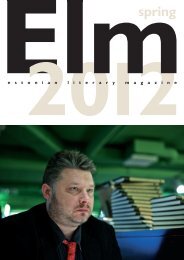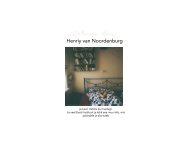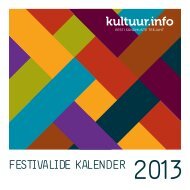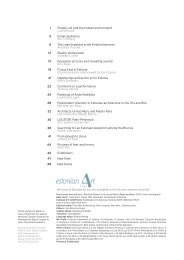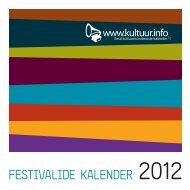Autumn 2013
Autumn 2013
Autumn 2013
Create successful ePaper yourself
Turn your PDF publications into a flip-book with our unique Google optimized e-Paper software.
sex are much more moderate than those in<br />
his earlier books. Sauter has turned into a<br />
lyricist, confessor and a gentle meditator, his<br />
slang-packed dialogues have become milder<br />
and there are even some hints of existential<br />
inner monologues (“Is the routine world only<br />
a masked room in a large loony-bin, or is the<br />
loony-bin still one room in the large world?”)<br />
The new book is frankly autobiographical:<br />
the characters carry the same names as in<br />
real life, and all the described events have<br />
happened to Sauter in his real life. The book<br />
opens with a post-divorce situation, and a<br />
search for escape from the resulting<br />
loneliness. “I hit on women directly, like<br />
hoping that they will all at once send me<br />
packing, and that’s what they do. This is the<br />
post-divorce brittleness. I don’t want to talk<br />
about love. I don’t need any romanticism, but<br />
I also don’t want to be alone.”<br />
Sauter depicts in his immediate, descriptive<br />
and plain style the bohemians’ communal life<br />
in an old wooden house, the death of the protagonist’s<br />
(i.e. the writer Sauter’s) son and his<br />
close relations with his daughter. The story<br />
ends at the moment when Peeter is again wearing<br />
a ring with the inscription “Don’t leave me<br />
alone”, and Laura is wearing another one with<br />
a similar inscription.<br />
This is “a love story” in a direct sense, a<br />
story of finding and cherishing love until<br />
there is somebody “together with whom I’d<br />
want to be silent when lying together in our<br />
grave. It’d be good to live with somebody<br />
with whom you’d want to be dead together.”<br />
This is a story of sadness, tiredness of life,<br />
approaching old age, and love. As surprising<br />
for Sauter as it may seem, it is a complete<br />
narrative. A middle-aged writer, “pot-bellied,<br />
with a beer glass in his hand, grey hair a<br />
mess, like any half-crazy middle-aged<br />
Estonian writer”, he wants to show and<br />
prove that he is not alone and sad but<br />
striving for happiness and well-being, for<br />
“quiet joyful peace”. But, now and then, he<br />
deliberately steps into embarrassing<br />
situations to find some absurdity in life and<br />
to avoid excessive seriousness and matterof-factness.<br />
The protagonist writer writes<br />
because writing can offer company and<br />
chase away loneliness. It offers you a mirror<br />
and a silent conversation partner with your<br />
own face – in literature you can meet your<br />
alter ego.<br />
This book gives us a summary that is<br />
characteristic of the writer’s life, and of the<br />
work itself: “Life is an empty, clueless<br />
existence, without great connections,<br />
obligations and even without any will. But<br />
this is the best. Like a nobody nowhere. I<br />
could say that I have fulfilled my dream of<br />
becoming a loser.” BM<br />
Elo Viiding<br />
Teised<br />
(The Others)<br />
Tallinn: Tuum, 2012. 174 pp<br />
ISBN 9789949918683<br />
Elo Viiding (b. 1974) was not even an adult<br />
when she debuted as a mature and original<br />
poet in 1990. The “star children”, described<br />
in one of her short stories, who have “sharp<br />
minds and quick wits and establish their own<br />
rules everywhere they go” and who “could,<br />
despite the surrounding rigidity, create a<br />
world where it was possible to talk about<br />
everything, where there was no place for<br />
stupidity and obedience, caution and<br />
prejudice” were, obviously, not a motif found<br />
in an empty space. In all of Viiding’s nine<br />
collections of poetry and three collections of<br />
short stories, her subject matter includes the<br />
being of woman, dissatisfaction with<br />
woman’s place and opportunities in society,<br />
as well as corporeality, psychoanalytical<br />
puzzles, and intellectual sharp irony and<br />
social criticism. Viiding’s relations with the<br />
world are brittle and full of anxiety; there is<br />
not much space for empathy because<br />
Viiding’s stakes are high, but they meet a<br />
dead end: she protests against the bourgeoisie,<br />
against superficiality and mental<br />
weakness, against soullessness and the lack<br />
of individuality. This is the protest of a





